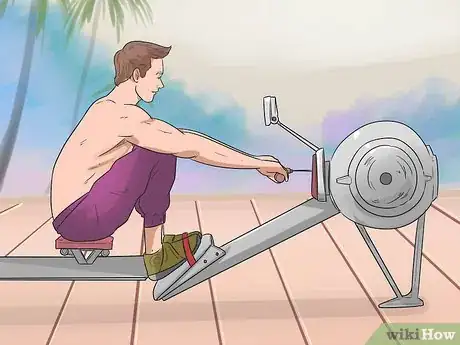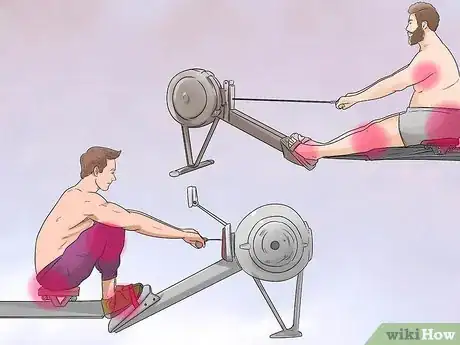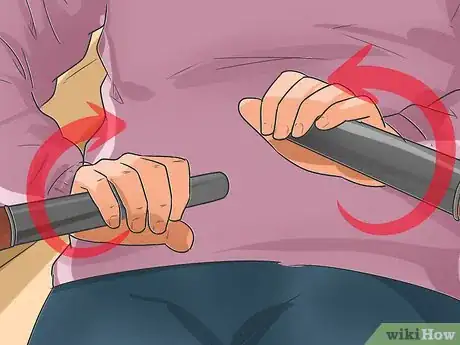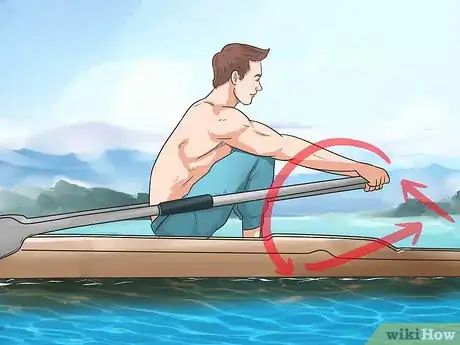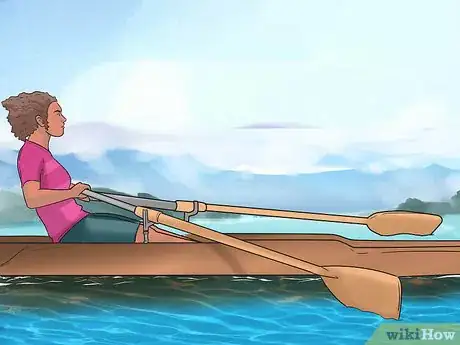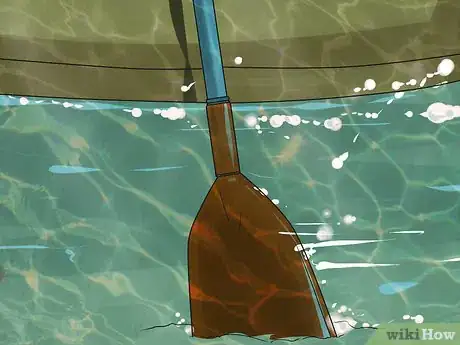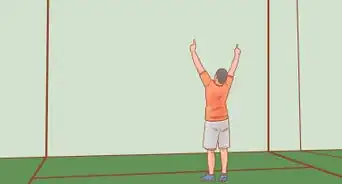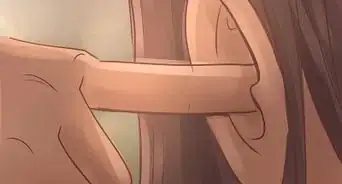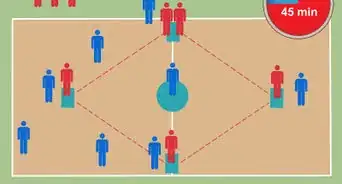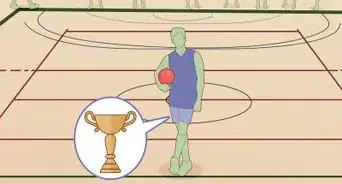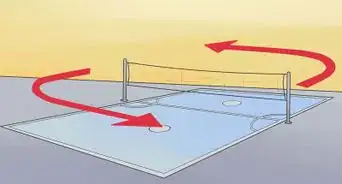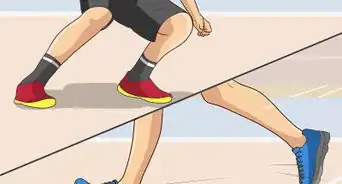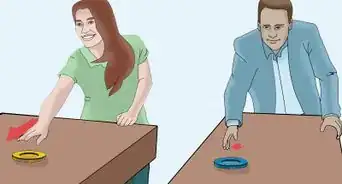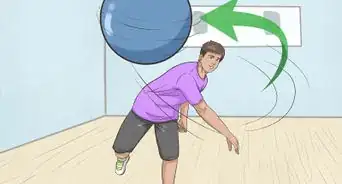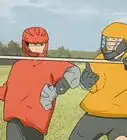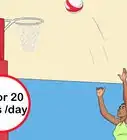This article was co-authored by Monica Morris. Monica Morris is an ACE (American Council on Exercise) Certified Personal Trainer based in the San Francisco Bay Area. With over 15 years of fitness training experience, Monica started her own physical training practice and gained her ACE Certification in 2017. Her workouts emphasize proper warm-ups, cool-downs, and stretching techniques.
This article has been viewed 132,339 times.
Rowing to some can be an intimidating endeavor, but once you learn the basic mechanics it just takes practice. You can row in different settings like on a rowing machine for exercise, in the water for "crew," or in a basic rowboat. Rowing takes a lot of power and strength, but if you take it slow at first, overtime you can build up the muscle and muscle memory it requires to master the skill of rowing.
Steps
Building Your Strength
-
1Practice on a rowing machine. The best way to prepare you to row on a boat in the water is by building your body strength on a water rower machine. This machine will target all the areas on your body that you will be using when in an actual boat: your legs, core, and upper body. You can purchase one of these machines for home use, or you can find them in many gyms or work out facilities.
-
2Strengthen your core. There are many exercises you can do to strengthen your core and abs. These exercises will help target not just your core, but your upper body as well:[1]
- Plank: Lie face down on the ground. Place your elbows on the ground underneath your shoulders with your forearms extended straight in front of you. Then, left yourself up on your toes and your forearms, keeping your body straight. Hold this position for 30 seconds to two minutes, increasing the amount of time you hold as you get stronger.
- Side plank: Begin in the same position as the plank and lift yourself up onto your arms and toes. Then, slowly turn your body to the side, so that your weight is resting on one foot and one arm (either your left foot and arm or your right). Make sure your body is in a straight line and you aren't leaning over. Hold this position for 30 seconds to two minutes and then switch to the other side.
- V-sit hold: Sit on the ground with your legs straight in front of you and your upper body straight. Then, extend your arms out in front of you and slowly lift your legs off the ground. As you lift your legs off the ground, keep them straight, and slowly lean your upper body back, making sure to keep your back straight as you do so. Hold this position for 30 to 90 seconds.
Advertisement -
3Target your lower body. Your lower body is important when it comes to rowing because 60 percent of the strength you use to row should come from your legs. There are many exercises you can do to improve lower body strength, but a few to start with are:
- Bridge: Lie on your back with you knees bent and feet flat against the floor, hip width apart. Then, slowly lift up your butt, using your glutes, until you have a straight line going from your shoulders to your knees. Hold the position for one to two minutes, or lower your butt and raise it again at a quick pace without letting your butt touch the ground. To make this position even harder, you can extend one leg straight out, keeping it in the air as you raise your butt.
- Barbell squat: Stand with your feet shoulder width apart and place a barbell behind your head across your shoulders and grip it with your hands. Squat like you are about to sit down, keeping your upper body straight and your chest out. Go as low as you can and then, stand back up and repeat. Do three sets of 12 reps.[2]
- Barbell/dumbbell lunges: Start by standing up with your feet together. Position the barbell as you did before, or hold a dumbbell in each hand. Then, take a step forward, bending your front knee so it creates a right angle, and lowering your back knee so that it almost touches the ground. Then, bring your back foot next to your front foot and repeat on the other side. You can do these in place, or you can do them walking. Try to do 50 yards of walking lunges.
-
4Strengthen your arms. Most rowers actually focus more on their core and legs because that is where most of their strength will come from, but it can be beneficial to improve your upper body strength as well. Along with doing planks, you can do a few of these exercises to improve your arm muscles:[3]
- Plank push ups: Start in the plank position, but instead of putting your elbows on the ground, you will put your hands underneath your shoulders. Push up to a plank position, with your weight on your hands and toes. Then, lower your body, keeping your elbows close to your body (you don't want them to push outwards away from the body). Don't allow your body to touch the floor, and then push yourself up again into that plank position.
- Reverse grip pulldowns: This exercise requires a pulldown machine. Sit at the machine and reach above you with an underhand grip to reach the pulldown bar. Then, slowly pull it down, using your upper body strength rather than momentum, until the bar is in line with your chest. Then, slowly allow the bar to go back to its starting position and repeat.
- Barbell rows: This is a great exercise to target the muscles you'll need for rowing. Position your hands shoulder width apart on a barbell on the ground with an overhand grip. Bend your body over so that your back is flat, in a table top position and your knees are straight or slightly bent, depending on your flexibility. Then, lift the barbell up to your chest, keeping your back flat, and lower back down (try not to let it touch the ground). Do five sets of five reps and try to place as much weight on the barbell as possible.
Using a Rowing Machine
-
1Position yourself. To begin rowing, you'll need to sit at the machine with your feet in front of you on the machine and your knees bent. Your arms will then be straight, extended in front of you, with your knees inside the arms. You will grab hold of the handle with both hands, and your stomach and chest should be resting against the tops of your thighs. This is called the "catch" position.[4]
-
2Know the different phases. Rowing on a machine consists of several different positions and phases. It's important to know these positions so that you can achieve the right movement on your machine. These movements can then be applied to competitive rowing in the water.[5]
- You start at the catch position, and then you move to the release position through the drive phase. The drive phase is when you are pulling the handle towards your body and extending your legs. The release position is the position at the end of the drive phase -- your legs are straight in front of you, your body is sitting upright, and your arms are pulled in towards you.
- Then, you will move on to the rock over phase, to the recovery phase, and finally back to your catch position. The rock over phase is when you begin to release your arms from the release position, allowing them to go straight, but keeping your legs straight. Then, in the recovery phase, as your upper body bends forward and your arms are fully straightened, you will begin to bend your knees until you've reached the catch position.
-
3Learn the linear progression. When you row, you aren't engaging your entire body at once -- there is a sequence involved. Rowing involves using your legs first (by first straightening them), then your core (by pulling your upper body back), then your arms (by pulling the handle to your chest). When you allow the handle to move back to its starting position you will do the reverse, first engaging your arms (by straightening them), then your core (by allowing it to be pulled forward), then your legs (by bending them).[6]
- If you engage your muscles out of order or all at once, it can be difficult to get your timing and rhythm right, and it can also decrease the amount of power you are able to use.
- Make sure when you pull the handle back, that you allow your legs to fully straighten before you initiate the power with your core. Then, when moving to your starting position, make sure your arms are fully straightened before you bend your knees.
-
4Perfect the power distribution. You are not engaging all parts of your body equally. When rowing, 60 percent of the power will come from your legs, 20 percent in your core, and then 20 percent in your arms.[7]
- If you use more arm strength than leg strength, you will be able to pull, but you won't be able to do so for long. Your upper body will get tired quickly and you'll begin relying on your momentum to pull rather than your strength.
-
5Practice the timing. Rowing also depends greatly on your timing. Instead of doing one count out and one count in, you will take one count out and two counts in. This means that as you pull the handle towards you and extend your legs in front of you, you will use one count. Then, as you allow the handle to move back to its starting position, allowing your arms to straighten and then your knees to bend, you will use two counts.[8]
- To get the right timing, you can practice saying "one" on the drive, and then "two, three" on the release and recovery phase. Or, you can say "power" on the drive and then "patience, patience" on the release and recovery phase.
- Timing your strokes is important because you want to make sure you have enough recovery. Because pulling takes more power, you'll need double the amount of time to release so that you can recover and prepare for your next pull.
Rowing in a Boat
-
1Sit down backwards in the middle of the boat. If you aren't sure where to sit, look for where the oarlocks are located. These are the small rings through which the oars are placed. Because the action of rowing is backwards, that is, the force of rowing propels you backwards, you should sit with your back to the bow (the front of the boat) and face the stern (the rear of the boat).
- If they aren't in place already, run the oars through the oar hooks so that the blade is in the water and the handle is in the boat. Make sure the oarlock points towards the back of the boat. If your oarlock faces the bow of the boat, it will be more difficult to row because the pitch of your blade will be off.
- Make sure the boat you are using to row in is an actual rowboat. If you row in a boat not designed for rowing, the task of rowing is going to be much more difficult. An ideal rowboat is 12 to 17 feet in length.
-
2Place your feet in the foot stretchers (if you have them). Some rowboats will come with foot stretchers that will need to be adjusted to the length of your legs. If you have longer legs, the foot stretcher may need to be adjusted so that it is farther away from you. To figure out where you foot stretchers need to be, push back in your seat until your legs are straight, and make sure the handles of the oars almost touch your body (but not quite).
- If you have lots of room between your handles and your chest when your legs are extended, you may need to move the foot stretchers away from you towards the stern. If you don't have much room between your handles and your chest, you may need to move your foot stretchers towards you, towards the bow.
- If you have more of a classic rowboat, or one that isn't designed for sports, you may not have foot stretchers or a seat that pushes backwards. In that case, you will still be doing similar arm movements as that of a rowing machine, but you won't be extending your legs.
-
3Grasp one oar in each hand with an overhand grip. Your hand should be at the end of the oar, with your thumb on the tip of the oar. A typical rowboat has two oars, and the oars should be about twice the length of the beam of the boat, which is the width of the boat. For a beginner, it's best to use oars that don't overlap when you are in the catch phase.
-
4Use the same motions as the rowing machine. If you have a rowboat that allows you to straighten your legs and push back as you row, you will use the exact same motions as a rowing machine. If your rowboat doesn't allow you to straighten your legs, then use the same arm movements, and lean back as you enter the drive phase, so that you are still relying on some of your leg strength.
- Make sure if you don't have the ability to extend your legs that you are using your shoulder and core strength and not your back to pull the oars towards you. However, your upper body should still only be some of the strength you are using. You want to use as much leg strength and lower body strength as possible. This may involve you using your glutes and hips for power.
-
5Begin with the catch position. In this position you will begin to put your blade into the water. You will sit as you would at a rowing machine, with your knees bent and your arms straight in front of you. The blades will rest above the water, perpendicular to the surface of the water. You will then prepare to move onto the drive.
-
6Take the drive. In this phase, you will be moving the blade through the water, with the blade going towards the stern of the boat. As you move from the catch position to the drive position, your blade should enter the water, and you will pull the handles of the oar towards you while also allowing your upper body to fall back and your legs to straighten. If you are in a boat that allows you to mimic the drive position of a rowing machine, then do so.
- Make sure blades are just underneath the surface of the water, and not buried deep into the water, as it will be more difficult to row the deeper the oar is.
-
7Move to the finish, or release position. This position is right before you take the blade out of the water, when your arms are bent, your back is straight and upright, and your legs are straight out in front of you. As you finished the drive phase, you should have pulled the handles of the oars towards your chest, and the blades should be in front of you, towards the stern of the boat.
- Once again, if you can copy the position of the release on the rowing machine, then do so. If not, keep your legs in whatever position you had them in, but make sure your upper body and your arms are positioned as they would be on a rowing machine.
-
8Enter the recovery phase. This phase is when you lift the blades out of the water, feather them, and then bring yourself to the catch position. As you take the blade out of the water, bring your upper body forward and begin to straighten your arms out in front of you. This will cause the handles of the oars to separate, and the blades will be pointed towards the bow of the boat.
- Feathering your oars essentially means that once you lift them out of the water, you will turn them so that they are parallel with the surface of the water, and hold them an inch or two above the water. This positioning of the blade will give you less wind resistance.
-
9Return to the catch position. Now that you've made one row, you will return to your beginning position and row again. In the catch position, you will turn the blades from their feathered position so they are perpendicular to the surface of the water, and then prepare to take another row.
-
10Use one oar to turn the boat. If you are looking to turn your boat in a different direction, simply use one oar instead of two oars. If you want to turn your boat to the left, for example, you would use the left oar, and use your strength to pull just that oar. This will cause your boat to turn to the left.
- If you want to turn on a smaller radius, hold water with one oar and row with the opposite oar. For example, if you are turning your boat to the right, place your left oar in the water and hold water, and row with your right oar.
- For an even smaller radius, take a normal stroke with one oar and a back stroke with the other oar. To turn left, do a normal row with your left oar, but then do a backwards row with your right oar. Essentially in a backwards row, you will be bringing one oar through the water and towards the bow of the boat versus a normal row where you move the oars through the water towards the stern of the boat.
-
11Stop your boat by digging your blade in the water. With your blade slightly feathered, meaning it's not totally parallel to surface of the water, but it's not completely perpendicular, dig your blade into the water. As you stick your blade in the water, straighten your arms and your boat should stop in a short time.
Expert Q&A
-
QuestionWhat muscles does a rowing machine workout?
 Monica MorrisMonica Morris is an ACE (American Council on Exercise) Certified Personal Trainer based in the San Francisco Bay Area. With over 15 years of fitness training experience, Monica started her own physical training practice and gained her ACE Certification in 2017. Her workouts emphasize proper warm-ups, cool-downs, and stretching techniques.
Monica MorrisMonica Morris is an ACE (American Council on Exercise) Certified Personal Trainer based in the San Francisco Bay Area. With over 15 years of fitness training experience, Monica started her own physical training practice and gained her ACE Certification in 2017. Her workouts emphasize proper warm-ups, cool-downs, and stretching techniques.
ACE Certified Personal Trainer Rowing workouts your latissimus dorsi, your trapezius, and your rhomboids.
Rowing workouts your latissimus dorsi, your trapezius, and your rhomboids.
Warnings
- Once the blade is under the water, avoid allowing it to sink any farther. This means your stroke should be completely horizontal.⧼thumbs_response⧽
- Avoid jerky, isolated, or uncompensated movements. This will take more strength and more time, resulting in a weak stroke.⧼thumbs_response⧽
- The water, after you have finished the stroke, should not look like a wave. It should be two small swirls of water, just below the surface.⧼thumbs_response⧽
- Don't reach with your arms. Use your hips to thrust the top of your body forward. The arms should only be used for the rowing motion.⧼thumbs_response⧽
- When finishing the stroke, don't pull out of the water too early. Make sure you are leaned back just a little and then pull out.⧼thumbs_response⧽
References
- ↑ https://www.rowperfect.co.uk/an-introduction-to-core-strength-for-rowing-static-exercises/
- ↑ http://www.shapefit.com/questions/exercise-questions-program-rowing-athlete.html
- ↑ http://www.shapefit.com/questions/exercise-questions-program-rowing-athlete.html
- ↑ http://www.howtorow.com/how-to-row/the-rowing-action
- ↑ http://www.howtorow.com/how-to-row/the-rowing-action
- ↑ http://www.howtorow.com
- ↑ http://www.howtorow.com
- ↑ http://www.howtorow.com
About This Article
To row on a rowing machine, start by sitting on the machine with your arms extended in front of you and your knees bent in between them. Grab the handle with both hands, and let your stomach and chest rest on the top of your thighs. Then, when you're ready, pull the handle toward you and extend your legs so you're sitting upright. Finally, extend your arms and bend your knees until you're back in the starting position. To learn how to row on a boat, scroll down!




